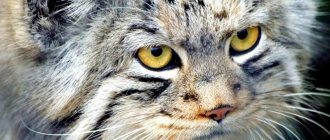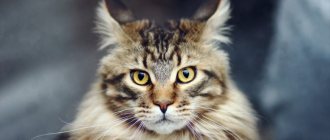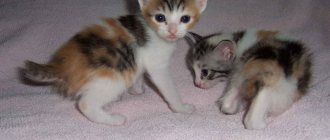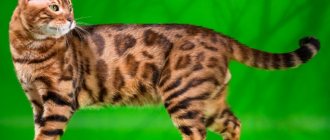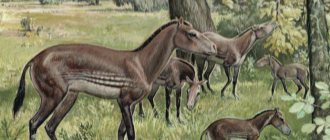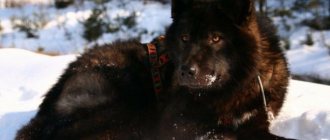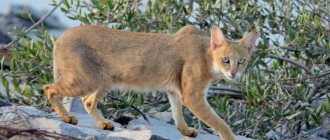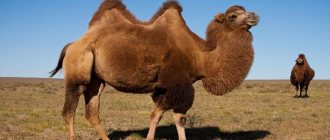The wild cat Manul is a small predator from the cat family that has rapidly captured the minds of millions of people on the planet. Luxurious thick fur and an intelligent look have turned a simple cat into a real Internet star.
Unfortunately, the fur coat attracts not only fans, but also poachers. Therefore, the wild cat is an animal from the Red Book. The population of this type of predator is under strict control and vigilant surveillance.
Description of Pallas's cat
Manul (lat. Felis manul synonym Otocolobus manul) is a charming representative of the cat family, known as the slowest and clumsiest of wild cats.
The owner of a fluffy fur coat and a calm expression on his face quickly became a favorite of Internet users around the world. Interest in this species has appeared quite recently; the breed is poorly studied at the moment.
The fluffy animal has many names: in certain circles the Pallas cat is known as Pallas's cat. It received such an unusual name in honor of its discoverer. In the 18th century, the German naturalist Peter Pallas met a wild cat on the shores of the Caspian Sea, and then included it in zoological reference books and encyclopedias.
Biologists call the Pallas's cat differently: the synonymous name otocolobus comes from the Greek “otos” - ear and “colobos” - ugly, that is, the literal translation sounds like “ugly ear”, although in fact the ears of the Pallas's cat are not that, they are very neat and cute .
This type of cat prefers solitude, and having once chosen a habitat, it remains faithful to it until the last days of its life. If by chance another cat sneaks into his territory, he will be immediately expelled in disgrace.
Everyday life
Pallas' cats are found in open spaces. They live alone and hunt at night, like most predators. His hunting target is all kinds of rodents. The manul is very slow in its movements and is rarely able to catch up with its prey. Having finished the hunt, the cat prefers to rest in a dwelling, often located in rock gorges or in other people's burrows. He sees females exclusively during the breeding season.
60 days after mating, the female brings offspring - kittens. As a rule, she gives birth to about six kittens. Their weight is about 250 grams, the average length is 12 centimeters. When kittens are 3 or 4 months old, they become hunters. After reaching the age of ten months, the kittens, already adults, leave their mother. Their lifespan is approximately 12 years.
What does it look like
A wild cat is not very different in size from a domestic cat, but it looks very impressive. The length of its body varies between 52-65 cm, the tail - within 30 cm, and the weight of the Pallas's cat, depending on the gender, can be either 2 kg or 5 kg.
The calling card of this cat is his fluffiness. The size of the predator looks impressive precisely because of its fur: the description of the animal in the reference book says that per square centimeter of the surface of its body there are up to 9000 hairs, which can reach a length of 70 cm each! One can only guess how much such a luxurious “fur coat” weighs.
The head, small compared to the body, has a flattened shape, in tandem with fluffy fur; this factor makes scientists consider Pallas' cats and Persian cats to be distant relatives. The head of a wild cat ends with small, widely set ears.
Yellow eyes also attract attention, the pupils of which do not take on a slit-like shape, like those of other felines, but remain round even in bright sunlight.
The Pallas's coat is a recognized record holder for the length and number of hairs. During the year, its fur has a light gray tint. The color changes slightly in winter and is an interesting combination of light gray and fawn. The hairs are not uniform in color, have white tips, resulting in a feeling of a snowy coating.
The tail does not differ in color from the main color, but at the end it has 6-7 transverse stripes of a darker shade. The underparts are brown with white overlay. The predatory facial expression of the charming wild cat is ensured by stripes on the sides of its muzzle: 2 black stripes stretch across its cheeks.
These cats are inhabitants of the arid steppe, evolution has taken care of the animal’s eyes: a high blinking speed allows them to remain hydrated and protected from sand.
How many Pallas' cats are left on earth?
According to the World Wildlife Fund (WWF), at the end of 2016, the total population of Pallas's cat numbered about 12 thousand individuals. In our country, most of these rare wild cats live in the Chita region. According to experts, there are from 2 to 2.5 thousand animals in the region. About 200-250 wild cats live in Buryatia and Tyva.
Counting the number of animals complicates their secretive lifestyle. However, even without an accurate determination of the number of Pallas's cats, it is clear that in recent decades there has been a gradual and stable decrease.
Lifestyle and nutrition of Pallas's cat
The steppe manul cat goes hunting at dusk: at night or early in the morning he ambushes, waiting for his prey near holes or stones. This predator is clumsy and slow; it will not be able to pursue its prey for long, so it chooses a different tactic. His strengths are his perseverance and fur, which blends perfectly with the colors of the surrounding area.
The Pallas' cat's daily menu consists of gape birds in the summer; the rest of the time he is not averse to dining on pikas and rodents, occasionally diluting his diet with clever gophers and hares. In bad times, the wild cat eats insects.
Diet
At night, the predator goes out hunting, slowly making its way through tall grass or sparse bushes. The cat makes sounds extremely rarely.
Manul prefers not to go far from his lair, so seeing him near human settlements is almost impossible. Pallas's cat will never be left without prey; his hunting skills are at a high level.
The main victims of the predator are small rodents. In addition to mice, gophers, pikas, he will not refuse to catch a hare, a marmot or even a small bird. However, in times of hunger the animal does not disdain even insects.
The approximate diet of the Transbaikal Manul under natural conditions consists of more than half of Daurian pikas, 1/5 of the daily volume it eats bugs, and about 10% of the prey consists of pigeons, swifts, partridges, bluetails, and quails. The remainder comes from ground squirrels, jerboas, hamsters, voles, berries and plants.
Habitat
A comfortable habitat for Pallas’ cats is the key to a long and well-fed life. The wild cat lives in nature in Central and Central Asia, and is found in Europe and even in Russia.
Often a name is assigned to a cat based on its place of residence. Thus, in Altai, in Tuva and in the Krasnoyarsk Territory, the Transbaikal Pallas's cat lives (all these areas are located just beyond Lake Baikal, they are called Transbaikalia).
Its Trans-Caspian brother is most common in more eastern latitudes: it is comfortably located in Uzbekistan, Pakistan, Iran and Kyrgyzstan. Tibetan Pallas' cats live in the steppes and mountain crevices of Nepal and, of course, Tibet.
The life and diet of a wild cat take place in steppe and semi-desert areas, covered with low grass and thickets of low bushes. The predator can handle small obstacles, but you won’t find it near steep cliffs.
Types of Pallas's cats
Within the species, there are three breeds for Pallas cats. They are not very different from each other, there is only a minor difference in color.
- The common or Siberian Pallas cat has a standard light gray color and lives in Siberia, Mongolia and China. It was this subspecies that was discovered by the naturalist Pallas;
- Central Asian Pallas's cat - this species is distinguished by its reddish-brown color and clearly visible reddish-brown stripes on its body. This subspecies has been known since 1842. The main habitats are Uzbekistan, Iran, Turkmenistan and Afghanistan.
- Tibetan Pallas's cat - its fur is darker than that of the usual representative of the breed, and in winter it acquires a precious silver tint. The forest cat lives in Tibet, Nepal, India and Pakistan. He became known to the world at the same time as his Central Asian brother.
External characteristics
Despite the similarities with the Persian and Angora breeds, the animal has distinctive features:
- ears are located almost at eye level;
- disproportionately short legs;
- fangs are 3 times longer than those of domestic cats;
- always a gloomy expression on the face;
- black transverse stripes on the body and cheeks;
- eyes are set wider apart than other cats;
- does not know how to meow, makes sounds similar to rumbling when he is dissatisfied or scared.
A striking difference from its domestic relatives: the Pallass cat’s pupils do not shrink from light
Character and behavior
Creating the image of a wild cat, the imagination draws pictures of an unbridled predator, ready to fight and chase. The character of the Pallas's cat is very different from the usual associations.
This is an extremely cautious animal, not ready to risk its health for the sake of the most coveted prey. In case of danger, he will not rush to run headlong - this is not his strong point.
The Pallas's cat is a master of camouflage; he can sit in a shelter, without moving or making a single sound, for quite a long time.
He feels good in the early morning and early hours of the night. The rest of the time, the cat is lethargic and inactive, giving preference to sleep and rest, he saves energy for really important matters - obtaining food and preserving his life.
When answering the question whether it is possible to tame a Pallas's cat, one cannot give a definite answer: a wild cat at home is an unusually rare and little-studied phenomenon.
A few owners of pets of this breed say that the animal has a cool disposition, is non-communicative and aggressive. He quickly forgets the person who fed him and shows the nature of a predator from the age of 3-4 months.
The manul does not like company and games, and tries to avoid both humans and other pets. In response to stroking, he may scratch or bite strongly.
Perhaps the popularization of the breed will do its job, and after just a few generations of animals born in captivity, Pallas' cat fans will be able to safely acquire furry friends.
Red Book
The number of Pallas's cats has recently begun to decrease slightly. Based on the sources of the latest reports for 2011, from ten to thirteen thousand cats were recorded in the reserves called Daursky. Establishing surveillance of it in other areas is problematic, since the Pallas' cat knows how to properly camouflage itself. The main reason for the death of Pallas cats is the human factor: the spread of chemical poisons used against mice. Rodents, in turn, are consumed by cats. This is also influenced by traps and snares into which individuals fall. And plus to everything - the natural enemies of cats are wolves and owls.
Manul at home
A wild manul cat can become a real hurricane: it is unpredictable and requires enormous patience on the part of the person who decides to purchase it. It does not get along very well with people: the animal does not feel gratitude for food and affection, and is practically not amenable to education.
The reality of owning a wild cat will be damaged furniture, torn curtains and wallpaper, and sleepless nights. The wild cat stays awake during the first half of the night and early in the morning, sleeping while the owner is at work.
Another problem will be the signature feature of the breed - its fluffiness. The domestic manul requires careful care, which must certainly include constant brushing, since the hair on these cats flies in clumps, and they shed almost all year round.
Kittens of this breed, raised in captivity, have poor immunity and often get sick. It is almost impossible to get them back on their feet, since, unlike an ordinary cat, there are currently no treatment methods.
It will not be easy to purchase a Pallas's cat: it is rare to find an official breeder, and catching animals is prohibited by Russian law.
The price for a healthy cat starts from 3 thousand dollars.
Before you decide to buy, you should carefully weigh the pros and cons and understand whether you can provide him with a comfortable life. A manul at home is a big responsibility.
Owner reviews
Ilya, 30 years old: “Actually, I didn’t intend to have any animals. Pal's cat was given away by friends and they were leaving. I thought it would be worse. But there are no particular problems with him. I live in a private house, there is a large yard, and the cat hangs out there all the time. He rarely comes home, eats and then comes back. Doesn't bite, doesn't scratch, can snort if he doesn't like something. And he doesn’t like my dog, but they hardly intersect.”
Maria, 25 years old: “Once, my husband and I did a noble deed: we saved an animal from a poacher. Later they found out that it was a Pallas's cat. He lived with us for a couple of months, ruined all the furniture, and scared the child. They gave it away at the first opportunity.”
Oksana, 32 years old: “I have long dreamed of a Pallas’s cat. I love cats, but I don’t have time to cuddle and play with them. I took a little cat, he was quite calm. Then she grew up (it was a cat) and began to demand a cat. I couldn’t find a mate, and my favorite’s character had completely deteriorated. She became angry, scratched and bit, the vet said it was a hormonal imbalance. I had to give it to the zoo, it’s a shame.”
Status and protection of the Pallas' cat
Everywhere, not excluding even nature reserves and protected areas, the Pallas's cat is rare or extremely rare. The fluffy wild cat Pallas often becomes a coveted trophy of poachers, who catch them for their luxurious fur and resale to exotic lovers.
A lot of individuals die every year from the paws of large dogs released from a leash; other animals fall into the placed nets and traps of would-be hunters.
But it is not only humans who are to blame for the fact that there are almost no Pallas' cats left. Sometimes animals cannot get food due to a decrease in the number of gophers and hares that they usually feed on. The wild cat also has its enemies in the animal world: often animals, especially young ones, are destroyed by wolves and eagle owls.
The Pallas's cat is listed in the Red Book of the Russian Federation and on the IUCN Red List with the status of "nearly endangered", and their numbers continue to decline. For more than 15 years, the status of the wild cat has been defined as rare even in its native habitat.
They are trying to increase the population of this species through captive breeding: the Pallas's cat is a well-known public favorite. But zoos often face high mortality rates in kittens under 3 months of age due to low immunity, although adult animals in captivity suffer relatively little, and their life expectancy almost doubles.
Reproduction
Sexual maturity in males and females occurs at the age of 10-11 months. The rutting period usually occurs at the end of February and beginning of March. Clashes may arise between males for the right to cover the female. After the mating season is over, the animals return to their territories. Feeding and raising the cubs is carried out exclusively by the female.
During pregnancy, which lasts 7-8 weeks, the cat prepares a place for future offspring. She brings from 2 to 6 kittens at a time. Until 10-12 days, babies remain blind and are completely dependent on their mother. The female feeds the cubs with milk for 3 months. Then the older kittens try to hunt on their own, remaining with their mother for several more months. Before the onset of puberty, young animals leave the female and look for a free area for hunting.
OCELOT
